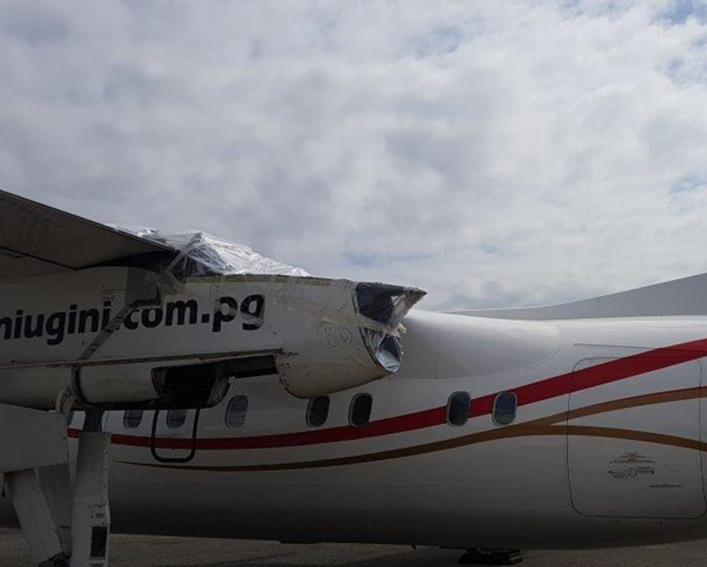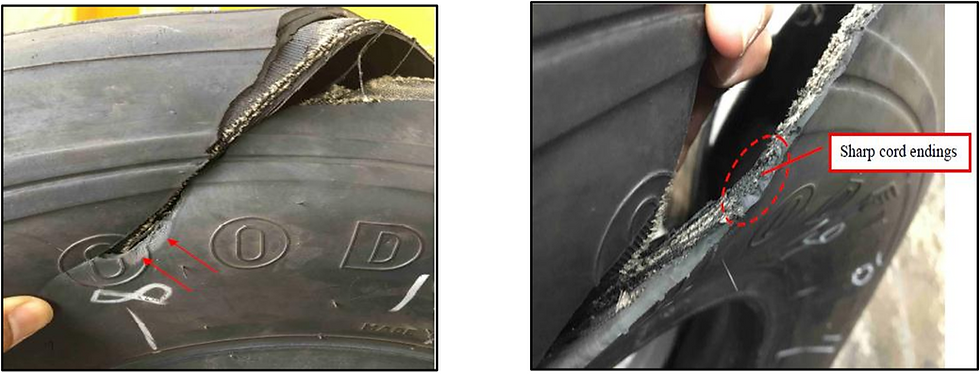4th of August 2017, Tyre Explosion, Blog #663
- V2Aviation

- Aug 4, 2024
- 3 min read
While passing 20.00 ft (climbing after take-off) the crew of a de Havilland Dash 8-202 heard a loud bang and felt the aircraft shake. Initial thoughts were an engine failure, but a scan of the engine instruments indicated they were operating normally.
Damage to the nacelle (Source & © AIC)
On board the aircraft were 28 passengers, two pilots, and one flight attendant. The flight preparation, including a preflight check by the pilot in command (PIC), and the take-off from Port Moresby's (Papua New Guinea) runway 14L had been uneventful.
After checking the engine instruments the co-pilot made a quick scan of the other indications and he observed an “unsafe left-hand main landing gear door indication” amber light, indicating the door was not closed, while it should have been closed. The PIC was advised and it was decided to return to Port Moresby, ATC was informed of their situation and their intention to return to Port Moresby, and the crew also indicated that a normal approach and landing was expected. The flight attendant had also heard the noise and informed the flight crew that she had seen the left main gear landing gear door open. Based on the available information the crew referred to the QRH (Quick Reference Handbook) and determined that they needed to remain below 15.000 feet and keep the speed below 130 knots.
The damaged nacelle is wrapped in plastic for protection (source & © AIC)
A holding pattern was requested to burn off fuel to achieve a landing weight of 15.650 kilograms. Once enough fuel had been burned off the aircraft made an uneventful landing at Port Moresby's runway 14L. After stopping the aircraft the crew realised that the groundstaff was looking at the lefthand side of the aircraft. After disembarking the passengers the crew was informed that panels were missing from the left engine (exhaust) nacelle. It was also found that the Left Hand inboard main wheel (number two main) was deflated, and damaged. It was concluded that the tyre blew out inside the nacelle, causing structural damage, which led to the panels departing the aircraft in flight. The Papua New Guinea Accident Investigation Commission (AIC) was alerted and an investigation was launched. As part of the investigation, the maintenance history as well as the flight history of the aircraft were analysed. The failed tyre assembly was shipped to the manufacturer where it was examined to determine the failure mode. The maintenance history of the assembly was reviewed and no anomalies were found. Evidence was found of hard-impact damage on the tyre wall and that the casing fracture was caused by FOD. The analysis revealed that the side wall of the tyre had been impacted by a hard object at serial side sidewall10 locations. After the casing plies at the impacted serial sidewall area severed, the fractured casing plies propagated along the cord direction to the tread area and the non-serial11 side sidewall.
The casing fractured along the casing-ply cord direction, across the tread area. The fractured area was between the serial side sidewall and the inside sidewall.
There was an impacted sign at the outside side sidewall,
The cord endings at the impact area were sharp. That indicated that the casing plies suddenly broke due to a hard impact
Detailed pictures of the failed tyre showing the impact area (left picture at red arrows) and sharp edges on the tyre cords (right picture circled0 (Source AIC © Good Year)
It was determined that the damage had occurred on an earlier flight to the Bulolo (gravel) airstrip. This airstrip had suffered from erosion due to continuous rain, exposing the sublayer of (embedded) stones.
Stones found at Bulolo airstrip (Source & © AIC)
The AIC concluded their report with the following analysis;
The FOD damage likely occurred when a jagged rock impacted the non-serial sidewall of the number two tyre during the landing at Bulolo on 3 August 2017. The aircraft returned to Port Moresby safely, but the damage was not found during post-and pre-flight inspections. During the subsequent flight after departure from Jacksons on 4 August, the casing plies in the impacted area fractured, propagating from the serial side sidewall along the cord direction to the tread area and the non-serial side sidewall. It is likely that the significantly damaged and weakened casing of the tyre, and the differential of the atmospheric pressure compared with the pressure within the tyre, caused the tyre to blow out, resulting in substantial damage to the left nacelle.
The AIC report, which served as the source for this blog can be accessed by clicking on the .pdf file below;











Comments